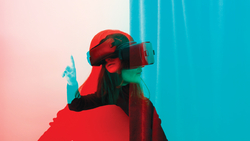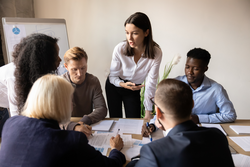ATD Blog
Research Backs Benefits of VR Training
Thu Jun 07 2018

Bookmark
Virtual reality (VR) technology is revolutionizing the way companies provide employees with engaging learning experiences that help them acquire knowledge and skills, achieve performance goals, and stay safe.
Not ready to buy into the hype?
Research points to several key reasons VR is an effective tool for training. Currently, VR is most suited to training cognitive skills related to remembering and understanding spatial and visual information and knowledge; psychomotor skills related to head movement, such as visual scanning and observational skills; and affective skills related to controlling emotional responses to stressful or difficult situations. In addition to the research on the types of training VR is good for, several studies highlight important attributes of VR. For instance, data suggests VR training can be more memorable than video content. And in practical terms, it is easily repeatable, scalable, and provides isolation from distractions. What’s more, it can provide a safe alternative to real world training.
VR Is More Memorable Overall
Many experts contend that the memory retention of subjects after a VR experience tends to be higher than after viewing video- or text-based learning materials. In their article in Education Psychology Review, authors James Clark and Allan Paivio explain how memory is anchored and made stronger when there is increased multi-sensory and emotional input. The idea is simple: as presence—and emotional responsiveness—increases, memory retention also improves. Research from S.A. Christianson concurs that the stronger an emotional reaction to a stimulus, the stronger the memory will be.
Indeed, when subjects feel presence in a VR experience, they feel like something is actually happening to them in real life, rather than simply observing. In one recent study, participants were presented with either a 360-degree VR video or a 2D video of a motorcycle ride. This was followed 48 hours later by a memory test. The results showed that the VR group performed twice as well as the video group in the memory recollection test. The researchers explained the performance differential by hypothesizing that immersive VR experiences become part of an extensive autobiographical associative network, whereas conventional video experiences remain as memories of isolated episodic events.
These findings are supported by a common observation from people who have watched a cinematic 360-degree video experience with a headset. When reflecting retrospectively on the experience, people typically report that it felt more like a memory of something that actually happened to them (autobiographical associative network) than a memory of a video of something that happened to someone else (isolated episodic event). Recollection of an autobiographical memory seems to be much stronger than the memory of an isolated episodic event.
Repeatable, Controlled Exposure to Emotional, Stressful Situations
Another powerful attribute of VR is that our emotional and physiological response to stimuli in virtual reality is closer to what we would experience in real life situations. This finding is most strongly supported by decades of research showing that VR can be used to treat phobia disorders and post-traumatic stress disorder. Case in point: During a VR experience, patients can be repeatedly exposed to a stressful stimulus in safe conditions. Over time, this sort of experience reduces the stress or fear response to that stimulus.
Additionally, because the experience is virtual, subjects can be exposed to varying levels of intensity (or dosage) of the experience. This is significant because the subject can become gradually accustomed to stronger stimuli. Any stressful situation can be turned into a safe VR experience—from seeing a snake to entering a plane to dealing with an angry customer.
Isolation From Distraction
A smaller, less-researched attribute of virtual reality training is the isolation and freedom from distraction that headsets provide. While it may sound Orwellian, this isolation is less about being trapped inside a headset and more about the increased engagement offered by VR. The more engagement and interactivity users experience, the less they are to feel the urge to check their phones or move on to the next distraction.
Think about it: Even when you’re binge-watching an incredibly addictive show on Netflix, you’re still prone to check your phone. By providing a sensory-rich VR experience via a headset, though, it is more likely to maintain engagement with the content as long as comfort levels remain high. (If nothing else, it’s a lot harder to check your phone.)
Safe Place to Learn
VR is provides many of the same benefits of training in a physical environment—but without the accompanying safety risks. If a subject becomes overwhelmed, they can easily take off the headset or adjust the experience to be less overwhelming. This simple fact makes means specific industries like healthcare, military, police, and so on should prioritize finding ways to use VR for training.
What the Future Holds
No doubt, a growing body of research reveals promising results for the potential of VR as a highly effective training technology—and that’s despite the lower quality of VR tech used in many of the earlier studies. Further, several of the barriers addressed in these studies have been overcome or are in the process of being eliminated. For example, a major obstacle to early VR training efforts has been the ability for instructional designers to produce and edit their own content. But with the advent of 360-degree video footage, this issue is easily overcome. In addition, more production and editing tools continue to hit the market (just look at what we’re doing at eevo).
Bottom line: VR offers a large number of benefits for learning a variety of skills, making it not so much a question of whether to use virtual reality solutions, but when and how to use VR for training.






